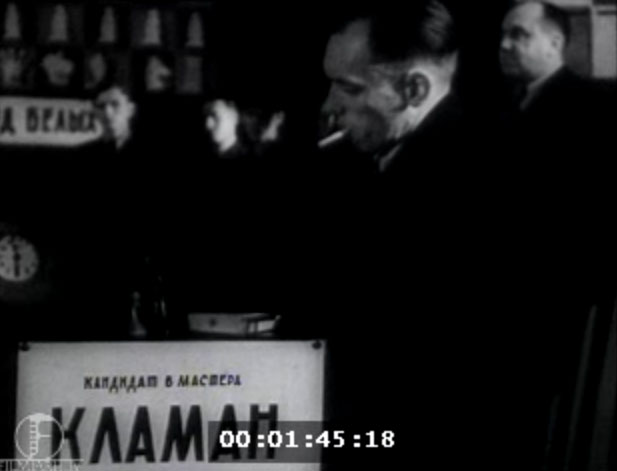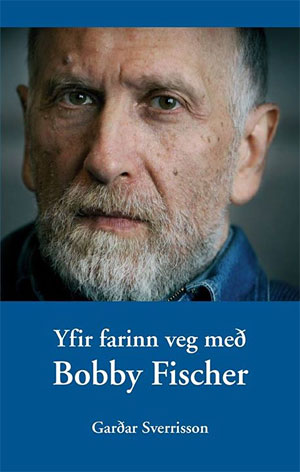


Leningrad, 12th February 1947. The tournament hall is packed to capacity. The 15th USSR Chess Championship is in progress. It’s the seventh round today. Konstantin Klaman, the local lad is facing Vassily Smyslov, grandmaster from Moscow. Now the rivalry between Leningrad and Moscow is well-known and the public is rooting for Konstantin. Only the other day their hero, Alexander Tolush had lost to Vassily Smyslov.
 You can watch the action in this silent footage provided by the Estonian site Filmiarhiivi Infosüsteem. In the video (click "Suurenda" to enlarge) we see the opening with pairs of player on the screen:
You can watch the action in this silent footage provided by the Estonian site Filmiarhiivi Infosüsteem. In the video (click "Suurenda" to enlarge) we see the opening with pairs of player on the screen:
A. Toluš and V. Smõslov, L. Aronin and V. Ragozin, S. Flohr and D. Bronstein, P. Keres and M. Kasparjan, Ufimtsev and G. Löwenfisch, Kan and K. Klaman, Goldenov and Dubinin. In the end, we have the medal and diploma being awarded to Paul Keres.
The local audience have their hopes pinned on Klaman. Not without reason. He is a dangerous tactician and a resourceful player. Only a few days before he has downed Paul Keres in a game in which the Estonian had overreached himself, and punished him for his aggression. But this time he has a tougher task.
At twenty-seven Smyslov is already a veteran of several USSR Championships, finishing right behind Botvinnik on more than one occasion. His style is marked by careful opening preparation, deep middlegame play and impeccable endgame technique. In this tournament, he has permitted only two fighting draws and otherwise beaten Tolush, Kan, Aronian and Ragozin in succession. In contrast, Klaman’s form has been variable, with ups and downs in round after round. The only bright spot in his play so far has been his game with Keres in the fourth round. But then hope springs eternal. Here we go!

[Event "?"] [Site "?"] [Date "1947.02.12"] [Round "?"] [White "Klaman, Konstantin"] [Black "Smyslov, Vassily V"] [Result "1/2-1/2"] [ECO "A47"] [Annotator "Nagesh Havanur"] [PlyCount "38"] [EventDate "1947.??.??"] 1. d4 Nf6 2. Nf3 ({Deviating from} 2. c4 {to avoid Smyslov's opening preparation}) 2... b6 3. Nc3 (3. c4 e6 4. Nc3 Bb4 {transposes to the Nimzo-Indian.}) ({and} 3. g3 Bb7 4. Bg2 {to regular lines of the Queen's Indian.}) (3. Bg5 Bb7 4. Bxf6 {inflicting doubled pawns is a Palliser recommendation. However, with two bishops Black is not without resources.}) 3... Bb7 4. Bg5 d5 {Romanovsky is critical of this move as it allows an early occupation of e5 by the White knight. However, there may be ways to neutralize the pressure.} (4... c5 {only allows White to expand with} 5. d5) 5. e3 e6 ({ not} 5... Ne4 6. Bb5+ c6 7. Bd3 Nxg5 8. Nxg5 $16) 6. Ne5 Be7 ({If} 6... Nbd7 $2 7. Bb5 c6 8. Nxc6 Bxc6 9. Bxc6 Rc8 10. Bb5 $16 {White is a pawn up.}) 7. Bb5+ c6 ({not} 7... Nbd7 $2 8. Bxf6 gxf6 9. Bxd7+ Kf8 10. Bc6 $18) 8. Bd3 c5 { This move could have waited.} ({It's preferable to complete development with} 8... Nbd7) 9. O-O {A routine move that allows Black to equalize.} ({Instead} 9. Bb5+ {deserves attention.} Kf8 {(Romanovsky suggestion) threatening...c4, encircling and trapping the bishop White may try} (9... Nbd7 $2 10. Bxf6 gxf6 11. Bxd7+ Kf8 12. Bc6 $18) (9... Nfd7 10. Bf4 $14 (10. h4 $5)) 10. Qf3 Qc8 11. Be2 $14) 9... O-O 10. Qf3 Nc6 (10... Nfd7 11. Bf4 Nxe5 12. Bxe5 Nd7 {also looks reasonable.}) 11. Qh3 g6 $2 {If Black is allowed to play...Re8 followed by...Bg7, he would have a satisfactory position. That is not to be.} ({He would have reached a level position with} 11... h6 $1 {He was probably concerned about} 12. Bxh6 (12. Bf4 Rc8 $11 ({or} 12... Nb4 13. Rac1 Nxd3 14. cxd3 $13)) 12... gxh6 $2 ({There was a draw with} 12... c4 $1 13. Bxg7 Kxg7 14. Qg3+ Kh8 $11) 13. Qxh6 Nxe5 14. dxe5 Ne4 15. f4 {followed by 16.Rh3 winning,}) 12. Ba6 $1 Qc8 (12... Bxa6 13. Nxc6 Qd7 14. Nxe7+ Qxe7 15. Qh4 Kg7 16. Bh6+ Kg8 17. Bxf8 Rxf8 18. Rfe1 $16) 13. Nxc6 Qxc6 14. Bxb7 Qxb7 15. Qh4 Kg7 16. Bh6+ Kg8 17. Bg5 {This leads to a draw by repetition of moves. It's possible that Klaman was in time trouble here.} ({Otherwise he would have played} 17. Bxf8 Rxf8 18. f3 $16 {with an exchange up and the better position.}) 17... Kg7 18. Bh6+ Kg8 19. Bg5 Kg7 1/2-1/2
An intriguing encounter! If you are seeing this game for the first time, you wonder why Klaman failed to gain the exchange and play for a win. Shakhmaty V. USSR, a well-known chess magazine in those days, carried a profile of the young player and the article also mentioned the game, claiming he allowed threefold repetition of moves through careless play. It’s more likely that he was in serious time trouble, improvising move after move as he did in the game.
When veteran master, Pyotr Romanovsky wrote his book on middlegame planning (it has seen two recent editions, one in Russian and the other in English) he included this game in his work. It caught the attention of young Fischer who was an avid reader of Russian chess literature. In the twilight years of life in Reykjavik he had neither forgotten the game nor Romanovsky’s book.
 In his recent book on Bobby Fischer, Garðar Sverrisson recalls how the legendary player shared his fascination for this little-known game with him and sought an improvement on Black’s play. One can only wonder what he would have found and how it would have enriched our understanding of the game. Sadly, he took it all to his grave.
In his recent book on Bobby Fischer, Garðar Sverrisson recalls how the legendary player shared his fascination for this little-known game with him and sought an improvement on Black’s play. One can only wonder what he would have found and how it would have enriched our understanding of the game. Sadly, he took it all to his grave.
To return to our protagonists here, the legacy of Vassily Smyslov is too well-known to bear repetition. Konstantin Klaman, however, is not a name that the chess world would recognize today. He was an engineer by profession and worked in the fire safety department at Leningrad. But his real passion was chess. In this event he came last, but earned the prize for the Best Game of the Championship for his win over Keres. It was the only loss of the Estonian, who went on to win the Championship (that game and Keres’ own participation in the Championship deserve a separate story).
Klaman did better in Leningrad Championships and indeed won the title in 1962. He also served as a trainer of young Spassky and helped him in preparation and analysis. Klaman was an individualist who went his own way and did not particularly care for the book. While his results suffered, public rejoiced as there was seldom a dull moment in his play.

Klaman Konstantin Alexandrovich (1917-1985), chess player, engineer, Master of Sports of the USSR, member of the championships of the USSR, the RSFSR and Leningrad, Champion of Leningrad. In the early 1960's he participated in the preparation of Boris Spassky. Klaman was buried at the Serafimovskoye cemetery.
Photos: Wiki Russia, Nekropol-SPB Russia
The film footage carries scenes from two USSR Championships, 1947 and 1950. Both were won by Keres. It was a matter of pride for Estonia. So they included them together in this footage. It is also of interest to see Ilya Kan and Pyotr Romanovsky.
Kan, a leading master in pre-war years scored only 9/19 in the 1947 Championship. He was the Tournament Director in 1950 Championship. He is the bald gentleman starting clocks. Pyotr Romanovsky was present in the 1950 USSR Championship and monitored its proceedings. He is the old man with silver hair, dressed in a coat and a tie seen in the footage.